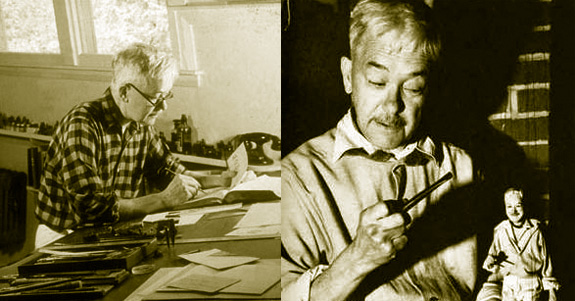January 3
“Your suggestion that I write a note about the work of my friend W.A. Dwiggins falls happily with my mood.” So began a letter written this day in 1939 by the President of the Society of Calligraphers, Dr. Hermann Püterschein. “. . . moreover,” continued the good doctor, “there are one or two points about his association with me that need to be cleared up, and this will be a convenient opportunity for that also.”
The mysterious relationship between William Addison Dwiggins, one of the great American graphic artists, and Hermann Püterschein was for many years a subject of controversy. The argument that Will Dwiggins was Püterschein was answered in rebuttal that really Püterschein was Dwiggin, and friends of both men were frequently called upon to untangle the riddle. Edmund G. Gress, editor of The American Printer, made a strong attempt to straighten the matter out in the columns of his periodical in 1927.
“Is there really a designer by the name of Will Dwiggins?” he asked. Through the agency of a Boston friend he secured the thumb prints of both men and printed them in the magazine, showing they were identical. Shortly thereafter he received a letter from Dwiggins: “I am inclined to take a lenient view of your attempt to merge my identity with that of Dr. Püterschein, but his reaction to the affair obliges me to regard it more seriously. . . . I forward to you the imprint of Dr. Püterschein’s thumb, also one of my own. I have taken the trouble to have a section of each enlarged.” The enlargements show the whorls of Püterschein’s print to be composed of Fraktur letters, while those of Dwiggins were joined fleurons in an engaging pattern.
“The thumb-prints and the enlargements taken together,” continued Dwiggins, “should certainly prove (1) that the fingerprints exhibited by you in a late issue of The American Printer are forgeries, and that (2) Dr. Püterschein and I are disparate individuals.”
Just about every person who has ever known Will Dwiggins and his graphic art realizes that he was one of the great masters of our time in a variety of disciplines—calligraphy, type design, book design, and ornamentation. “I have known the artist for a long time,” said Dr. Püterschein. “Probably I know more about the steps of his development that any other individual.” And here is the hint that Dr. P. was indeed at one and the same person as WAD, an alter ego in residence, so to speak.
Adopted as a pen name for Dwiggins’ many excursions into print, the apocryphal doctor almost became a noted figure in his own right, but the warmth of his personality and his whimsical viewpoint so akin to that of his master are perhaps the best clues to his real identity.
